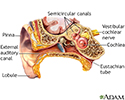Benign ear cyst or tumor
Osteomas; Exostoses; Tumor - ear; Cysts - ear; Ear cysts; Ear tumors; Bony tumor of the ear canal; FurunclesBenign ear cysts are lumps or growths in the ear. They are not cancerous.
Causes
Sebaceous cysts are the most common type of cysts seen in the ear. These sack-like lumps are made up of dead skin cells and oils produced by oil glands in the skin.
Sebaceous cysts
An epidermoid cyst is a closed sac under the skin, or a skin lump, filled with dead skin cells.
Read Article Now Book Mark ArticleCysts
A cyst is a closed pocket or pouch of tissue. It can be filled with air, fluid, pus, or other material.

Places they are likely to be found include:
- Behind the ear
- In the ear canal
- In the earlobe
- On the scalp
The exact cause of the problem is unknown. Cysts may occur when oils are produced in a skin gland faster than they can be released from the gland. They can also occur if the oil gland opening has become blocked and a cyst forms under the skin.
Benign bony tumors of the ear canal (exostoses and osteomas) are caused by excess growth of bone. Repeated exposure to cold water may increase the risk for benign bony tumors of the ear canal.
Benign
Benign refers to a condition, tumor, or growth that is not cancerous. This means that it does not spread to other parts of the body. It does not in...

Symptoms
The symptoms of cysts include:
- Pain (if cysts are in the outside ear canal or if they get infected)
- Small soft skin lumps on, behind, or in front of the ear
The symptoms of benign tumors include:
-
Ear discomfort
Ear discomfort
An earache is a sharp, dull, or burning pain in one or both ears. The pain may last a short time or be ongoing. Related conditions include:Otitis m...
 ImageRead Article Now Book Mark Article
ImageRead Article Now Book Mark Article - Gradual hearing loss in one ear
Hearing loss
Hearing loss is being partly or totally unable to hear sound in one or both ears.
 ImageRead Article Now Book Mark Article
ImageRead Article Now Book Mark Article - Repeated outer ear infections
Note: There may be no symptoms.
Exams and Tests
Benign cysts and tumors are most often found during a routine ear exam. This type of exam may include hearing tests (audiometry) and middle ear testing (tympanometry). When looking into the ear, the health care provider may see cysts or benign tumors in the ear canal.
Audiometry
An audiometry exam tests your ability to hear sounds. Sounds vary, based on their loudness (intensity) and the speed of sound wave vibrations (tone)...

Tympanometry
Tympanometry is a test used to detect problems in the ear drum and middle ear.

Sometimes, a CT scan is needed.
CT scan
A computed tomography (CT) scan is an imaging method that uses x-rays to create pictures of cross-sections of the body. Related tests include:Abdomin...

This disease may also affect the results of the following tests:
-
Caloric stimulation
Caloric stimulation
Caloric stimulation is a test that uses differences in temperature to diagnose damage to the acoustic nerve. This is the nerve that is involved in h...
 ImageRead Article Now Book Mark Article
ImageRead Article Now Book Mark Article -
Electronystagmography
Electronystagmography
Electronystagmography is a test that looks at eye movements to see how well nerves in the brain are working. These nerves are:Vestibular nerve (eigh...
Read Article Now Book Mark Article
Treatment
Treatment is not needed if the cyst does not cause pain or affect hearing.
If a cyst becomes painful, it may be infected. Treatment may include antibiotics or removal of the cyst.
Benign bony tumors may increase in size over time. Surgery may be needed if a benign tumor is painful, interferes with hearing, or leads to frequent ear infections.
Outlook (Prognosis)
Benign ear cysts and tumors are slow-growing. They may sometimes shrink or may disappear on their own.
Possible Complications
Complications may include:
- Hearing loss, if the tumor is large
- Infection of the cyst
- Infection of the ear canal
- Wax trapped in the ear canal
When to Contact a Medical Professional
Contact your provider if you have:
- Symptoms of a benign ear cyst or tumor
- Discomfort, pain, or hearing loss
References
Gold L, Williams TP. Odontogenic tumors: surgical pathology and management. In: Fonseca RJ, ed. Oral and Maxillofacial Surgery. 3rd ed. Philadelphia, PA: Elsevier; 2018:chap 18.
Hargreaves M. Osteomas and exostoses of the external auditory canal. In: Myers EN, Snyderman CH, eds. Operative Otolaryngology Head and Neck Surgery. 3rd ed. Philadelphia, PA: Elsevier; 2018:chap 127.
Nicolai P, Mattavelli D, Castelnuovo P. Benign tumors of the sinonasal tract. In: Flint PW, Francis HW, Haughey BH, et al, eds. Cummings Otolaryngology: Head and Neck Surgery. 7th ed. Philadelphia, PA: Elsevier; 2021:chap 50.
-
Ear anatomy - illustration
The ear consists of external, middle, and inner structures. The eardrum and the 3 tiny bones conduct sound from the eardrum to the cochlea.
Ear anatomy
illustration
-
Melanoma and other skin cancers - InDepth
(In-Depth)
Review Date: 5/2/2024
Reviewed By: Josef Shargorodsky, MD, MPH, Johns Hopkins University School of Medicine, Baltimore, MD. Also reviewed by David C. Dugdale, MD, Medical Director, Brenda Conaway, Editorial Director, and the A.D.A.M. Editorial team.



